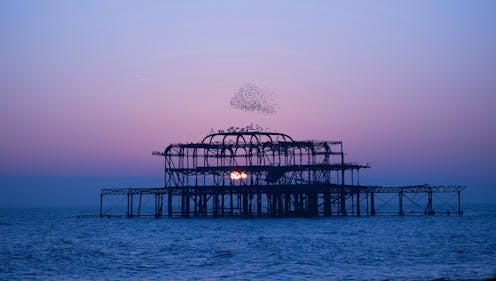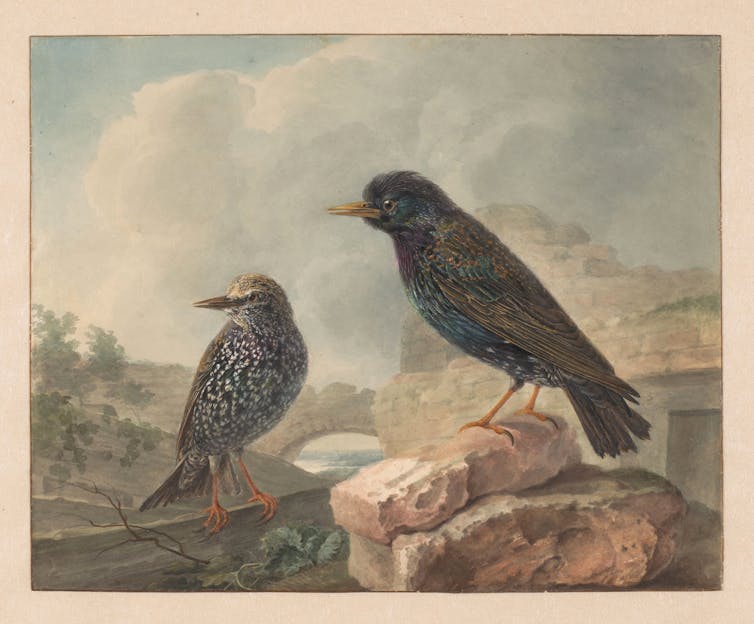
I’m sitting on the sofa, watching starlings. There are thousands of them circling above and around me, swirling into spectacular, ever-shifting shapes. They curve and loop in a hypnotic dance, merging at times into thick knots of winding blackness.
The sound is equally astonishing: a wave of wing beats that pulses as the starlings snake across the sky. This compelling communal performance, known as a murmuration, culminates in the act of roosting. It’s the grand show put on before the starlings settle in for a winter night.
It takes some effort or luck to witness a murmuration of starlings outside, but from the comfort of my house – and within the frame of a television screen – I can access them easily. The second episode of Wild Isles, which premiered on the BBC last week, features an especially memorable and surprising sequence of starlings roosting on Bodmin Moor in Cornwall.
Sequences such as this, filmed using technology including drones and night cameras, are not just good value as entertainment, but are critical tools when it comes to understanding bird behaviour.
In the last few months, the BBC has also published several videos of murmurations filmed across the United Kingdom, mostly shot by amateur filmmakers. These are equally valuable resources, not least because they foreground the humans behind the camera.
We don’t just see the birds here, but we get to hear the live reactions of people to the birds. This reminds us that a murmuration is an increasingly social event, exemplifying what cultural geographer Andy Morris calls: “environmental entanglement between humans and non-humans”.
The spectacle of the murmuration tells us as much about people as it does about birds.
The art of bird watching
As an art historian, I find the questions of why and how humans look at animals fascinating and significant. What does it mean to sit on a sofa watching starlings?
Wild Isles is part of a long and complex tradition of representing or framing wildlife that includes a wide variety of images and objects. As I watched the episode, I wondered what a comparable experience might have been, say, 200 years ago.

When people couldn’t film birds, they drew or painted them, usually in such a way as to communicate complex information about appearance and behaviour, but not so much as to seem artless.
Cornelis van Hardenbergh’s watercolour painting, Two Starlings (c.1800), is a good example of this. It portrays a male and female starling in brilliant detail. The two birds, probably drawn from dead specimens, are carefully posed in a scenic landscape.
As a static image, so clearly dictated by the priorities of its human viewers, I can understand why this painting might not attract a large audience today. But I think there is much to be gained by comparing such images with their contemporary equivalents.

Not only does it draw attention to the framing that still takes place within filmed representations of wildlife, but it can remind us of what is missing when we view animals through moving images, not least the opportunity to consider the birds at our leisure – and in silence.
Spend a few minutes with Van Hardenbergh’s painting and you might find it every bit as thrilling as a video of a murmuration. Van Hardenbrugh’s starlings are part of a group of images and objects that art historians have often struggled to classify. Is this art or does it belong to the history of science?
Paintings such as this can be found both in the collections of natural history museums and fine art museums (this example comes from the Rijksmuseum in Amsterdam).
What it means to look at an animal is the kind of question, ultimately, that requires knowledge of several disciplines. It challenges art historians to brush up on their biology. It also points to the vital role that art and visual culture have played – and should still play – within the natural sciences.
I’m part of an interdisciplinary research group called Open Ecologies and one of our current projects, Art and Climate Change, considers the role that historic art can play in educating people about ecological breakdown. We believe that objects from the past, such as paintings, can be just as valuable as educational tools as videos created using the latest technologies.
We want to bring together objects and images from natural history and fine art museums, and to combine ideas from a range of disciplines, to tackle big questions about the way humans represent and understand non-human animals and habitats.
I’ve also been putting together an online exhibition, which showcases the drama and diversity of UK collections, focusing on representations of species that feature in the BBC Wild Isles series.
Each week new items will be added. This week I’ve included some starlings: including a stunning painting of starlings by the Northumberland artist Jimmie Floyd. I believe the painting complements the moving images of murmurations with which we have become familiar.
There’s no stunning detail here: no extraordinary camerawork, no radical insights into bird behaviour. But as a representation of an experience, the painting is compelling. There have been, and are, many ways of seeing starlings – and they all have something to tell us.
Samuel Shaw has in the past received funding from the Arts and Humanities Research Council
This article was originally published on The Conversation. Read the original article.







